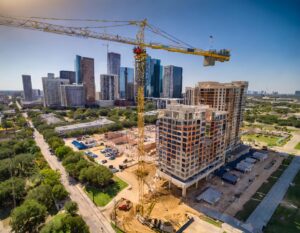Page Contents
- Houston Multi-Family Market Summary
- Leasing Momentum and Absorption Trends
- Challenges in Lower-Tier Segments
- Inflation and Eviction Trends
- Supply and Vacancy Rates
- Short-Term Pressure on Vacancy Rates
- Long-Term Market Outlook
- Houston’s Rent Comparison with Other Cities
- Rent Affordability in Houston
- Year-Over-Year Rent Growth Trends
- Vulnerability and Profitability in Different Property Ratings
- Rent Gains in Workforce Housing Submarkets
- Concession Trends in Houston’s Housing Market
- Future Rent Growth Forecast
- Rising Construction Costs and Ongoing Projects
- Luxury Segment Dominates Recent Construction
- Construction in Affluent Suburban Areas
- Supply-Side Risks in Affluent Urban Submarkets
- Trend of Mixed-Use Developments
- Rise of Single-Family Build-to-Rent Products
- Decline in Sales Activity Due to Higher Borrowing Costs
- Shift in Buyer Pool Composition
- Stabilization of Pricing and Rising Cap Rates
- Continued Activity by Value-Add Investors
- Presence of National Buyers
- Closing Thoughts
Houston Multi-Family Market Summary
- Current State of Houston’s Multi-family Market: Houston’s multi-family market has seen a modest rise in demand, yet it remains historically weak. All market segments, especially the 3 Star and 1 & 2 Star categories, have experienced a slowdown since 2022. The luxury segment is the only one showing buoyant demand.
- Impact on Renters: Rising evictions and unaffordability are problematic for mid-tier and workforce housing renters. In less than two years, average monthly rents have jumped by about $145. This increase translates to an additional $1,740 per year for renters.
- Inflation Trends: Inflation has significantly decreased over the past year, offering some relief. Last summer, it reached double digits, impacting the housing market. This decrease is a positive sign amidst current market challenges.
- Rent Growth and Vacancy Rates: Weaker demand and new supply have slowed rent growth and increased vacancies. Houston’s vacancy rate stands at 10.1%, above the 10-year average of 9.2%. Rent growth has decelerated each quarter since late 2021, now at 1.0% year-over-year.
- Performance of Different Submarkets: Affordable submarkets like South Galveston County, Alief, and Greenspoint/I.A.H. Airport outperform others. In contrast, expensive areas like Downtown and The Woodlands have seen rent losses. This trend highlights the varying performance across Houston’s submarkets.
- Supply and Demand Dynamics: Since 21Q4, new supply additions have consistently outpaced demand. CoStar projects over 21,000 new units, a three-year high. If demand remains low, vacancies could continue to rise.
- Construction Trends: Houston is a top market for construction, yet development remains disciplined. With 4.5% of inventory underway, it’s below the national average of 5.4%. Suburban areas, particularly to the north and west, lead in construction activity.
- Population and Employment Growth: Houston is a leader in employment and population growth, attracting apartment developers. From 2021–22, it ranked second in U.S. population growth, adding nearly 125,000 residents. The metro has added 160,000 new multi-family units since 2013, growing its inventory by 30%.
- Investment Climate: Elevated interest rates and economic uncertainty have led to a drop in investment. Market pricing has stabilized, and cap rates have risen by 100 to 125 basis points a year.
- Long-Term Market Outlook: Despite current challenges, there’s a positive long-term outlook for Houston’s multi-family market. Stakeholders remain optimistic about Houston’s job and population growth potential, driving future multi-family demand. This optimism is crucial for strategic partners and real estate private equity in the capital group sector.
Leasing Momentum and Absorption Trends
The momentum in Houston’s multi-family market rebounded.However, annual net absorption figures are still below typical trends, with only 6,500 units absorbed in the past 12 months compared to the five-year average of 15,000 units. This absorption is primarily in 4 & 5 Star communities, with areas like Neartown/River Oaks showing positive annual absorption.
Challenges in Lower-Tier Segments
Lower-tier segments, particularly Class B (3 Star) and the lowest-tier inventory have seen a decline in absorption. This downturn, with Class B at -960 units and the lowest tier at -1,500 units, is likely due to inflation, significant rent increases, and a surge in evictions. Monthly evictions in Houston have dramatically increased since early 2022, exacerbating these challenges.
Inflation and Eviction Trends
 Houston has experienced a sharp rise in evictions, averaging 6,800 monthly in the first half of this year, a significant increase from previous years. On a positive note, inflation measured by the CPI fell under 2% in June, the first time since March 2021, aligning more closely with Houston’s typical 20-year average.
Houston has experienced a sharp rise in evictions, averaging 6,800 monthly in the first half of this year, a significant increase from previous years. On a positive note, inflation measured by the CPI fell under 2% in June, the first time since March 2021, aligning more closely with Houston’s typical 20-year average.
Supply and Vacancy Rates
Over the past year, 21,000 new units have opened in Houston, leading to a rise in the vacancy rate to 10.1%, up from 7.3% two years ago. However, this increase is not due to overbuilding, as construction has been moderate. Areas with heavy workforce housing, like Greenspoint/IAH Airport, have lower vacancies due to minimal supply pressure.
Short-Term Pressure on Vacancy Rates
With 31,000 units underway, experts anticipate a moderate rise in Houston’s vacancy. Demand may remain modest and must be sufficient to balance new supply additions. Houston’s vacancy rate increase is relatively benign compared to other Sunbelt markets like Nashville and Jacksonville.
Long-Term Market Outlook
Houston’s long-term outlook remains favorable, consistently ranking high for population growth among Sun Belt metros. Strong net migration and household growth should continue to drive demand for apartments. Single-family home dynamics, including lower permit numbers and higher mortgage rates, will likely bolster renter demand soon.
Houston’s Rent Comparison with Other Cities
Houston’s average asking rent is $1,320/month, about 30% lower than Austin and the U.S. average and 20% below D-FW. A decade ago, the U.S. had a 15% rent premium over Houston, indicating slower rent gains in Houston compared to the national average. Houston’s multi-family stock grew by 30% in the last ten years, surpassing the national average of 23%.
Rent Affordability in Houston
The median household income in Houston is $77,000, with average rent consuming about 20% of this income. Downtown Houston has the highest rents at $2,400/month, while affluent suburbs like The Woodlands and Cinco Ranch see rents around $1,600/month. Lower-rated areas like Greenspoint/IAH Airport and Alief have the lowest rents, at $880 and $980/month respectively.
Year-Over-Year Rent Growth Trends
Houston’s year-over-year rent growth stands at 1.0%, a significant drop from the 9.2% peak in 21Q4. However, it’s outperforming its Texas Triangle peers, who are all currently posting rent losses. With the expected addition of 21,000 units, this decelerating trend in rent growth is likely to continue.
Vulnerability and Profitability in Different Property Ratings
In Houston’s current market, four and 5-star properties are most vulnerable due to new supply, while 3-star properties are profiting from the high demand for affordable housing. Despite recent demand falls, 3-star properties led rent gains with a 2.1% increase over the past 12 months, whereas 4 & 5 Star properties saw a -0.2% adjustment.
Rent Gains in Workforce Housing Submarkets
Submarkets with substantial workforce housing, like Alief and Greenspoint/IAH Airport, have shown significant rent gains over the past year. In contrast, supply-heavy urban areas like The Heights and Downtown have experienced weaker rent gains. The prevalence of concessions has increased across Houston, particularly in supply-heavy areas.
Concession Trends in Houston’s Housing Market
The number of buildings offering concessions in Houston, such as free rent for multiple months, has risen significantly. While less common in the suburbs, concessions like one month of free rent are typical in active construction submarkets like Bear Creek/Copperfield.
Future Rent Growth Forecast
Analysts predict that rent growth in Houston will continue to slow in the near term, with an anticipated increase of only 0.8%, marking the slowest rate since 2020. Analysts attribute this slowdown to a moderate recession predicted. Despite this, they expect Houston’s rent growth to outperform Austin, D-FW, and San Antonio through 2024, as these markets confront more significant challenges with new supply.
Rising Construction Costs and Ongoing Projects
Construction costs in Houston have risen by 30-50% over the past two years, influenced by supply chain issues and higher debt costs. Despite these challenges, construction activity remains steady, with 31,000 units underway, aligning with the five-year average of 29,000 units.
Luxury Segment Dominates Recent Construction
 Houston added 160,000 net units in the past decade, with over 88% in the four and five-star luxury segment. The current construction trend continues to favor luxury apartments, although three-star-level community developments have a noticeable increase.
Houston added 160,000 net units in the past decade, with over 88% in the four and five-star luxury segment. The current construction trend continues to favor luxury apartments, although three-star-level community developments have a noticeable increase.
Construction in Affluent Suburban Areas
Suburban areas like Northwest Houston and Bear Creek/Copperfield are critical drivers of construction, reflecting Houston’s population growth. Notable projects include the Indigo Commons low-rise in Richmond, part of a mixed-use ‘agri-hood’ emphasizing walkability and community amenities.
Supply-Side Risks in Affluent Urban Submarkets
Neartown/River Oaks, an affluent urban area receptive to density, faces supply-side risks with around 1,600 units underway. Experts anticipate that this influx of new supply will impact the area’s vacancy rates in the short term.
Trend of Mixed-Use Developments
Mixed-use developments are increasingly popular in areas like Neartown/River Oaks, a significant retail and high-end dining hub in Houston. Projects like GID Development Group’s Regent Square highlight this trend, combining residential units with retail and leisure spaces.
Rise of Single-Family Build-to-Rent Products
The development of single-family build-to-rent units is a growing trend in Houston, with over 3,300 units underway. Low inventory, high home prices, and elevated mortgage rates drive demand for these units, particularly in low-density areas.
Decline in Sales Activity Due to Higher Borrowing Costs
Houston’s multi-family market sales have significantly slowed in recent months, primarily due to increased borrowing costs. The total sales volume has decreased for four consecutive quarters, reaching the lowest first half since 2020.
Shift in Buyer Pool Composition
There’s been a notable shift in the composition of the buyer pool in Houston’s multi-family market. Institutional capital and private equity have become cautious, with private capital now driving the majority of investment volume, accounting for over 60% of buyer volume in the past year.
Stabilization of Pricing and Rising Cap Rates
After a significant increase in price per unit from mid-2017 through mid-2022, pricing in Houston’s multi-family market has flattened since mid-2022. Rising treasury and commercial real estate lending rates are pushing cap rates higher, with many recent large sales reporting cap rates above 5%.
Continued Activity by Value-Add Investors
Despite the overall slowdown in sales, value-add investors remain active in the market. For example, Houston-based Disrupt Equity Partners purchased the Derby at Steeplechase for $32 million, planning to implement value-add initiatives to increase rents.
Presence of National Buyers
National buyers, while more selective, are still present in the Houston market. In 23Q2, New York-based Weiss Property Group acquired the Virtuo Med Center, a 326-unit property, for an estimated $75 million. This indicates ongoing interest from national investors in Houston’s multi-family sector.
Closing Thoughts
In conclusion, while facing challenges such as increased construction costs, shifting buyer pools, and fluctuating cap rates, Houston’s multi-family market continues to present diverse opportunities for investors. The market’s dynamics, from the rise in value-add investments to the enduring interest of national buyers, underscore its resilience and potential for growth. Expert guidance is crucial for those looking to navigate this complex and evolving landscape. We invite you to contact Lumicre for your real estate investment needs. Our team offers deep insights and tailored strategies to help you capitalize on Houston’s multi-family market opportunities.